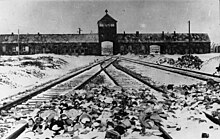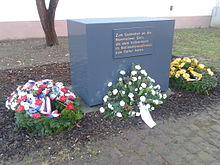Day of Remembrance for the Victims of National Socialism

The Day of Remembrance of the Victims of National Socialism on January 27 in Germany since 1996 a nationwide, of statutory Memorial . It is the anniversary of January 27, 1945, the day of the liberation of the Auschwitz-Birkenau extermination camp and the two other Auschwitz concentration camps by the Red Army in the last year of World War II . For the International Day of Remembrance of the Victims of the Holocaust on January 27 by the was the United Nationsdeclared in 2005. The day of remembrance is now also celebrated in many European countries.
Remembrance day in Germany
The Day of Remembrance of the Victims of National Socialism commemorates all victims of an unprecedented totalitarian regime during the time of National Socialism : “We remember the disenfranchised, tortured and murdered: the European Jews , the Sinti and Roma , the Jehovah's Witnesses , the millions of displaced Slavs , the… forced laborers , the homosexuals , the political prisoners , the sick and the disabled , all those who declared enemies of the National Socialist ideology and persecuted them. We remember ... even to those who brave resistance contributed or granted other protection and assistance. "
The day of remembrance was introduced on January 3, 1996 by the proclamation of the Federal President Roman Herzog and set to January 27. On January 27, 1945, soldiers of the Red Army liberated the survivors of the Auschwitz-Birkenau concentration camp , the largest extermination camp of the Nazi regime.
In his proclamation, Herzog stated:
“The memory must not end; it must also warn future generations to be vigilant. It is therefore important to find a form of remembrance now that works in the future. It should express grief over suffering and loss, be dedicated to the memory of the victims and counteract any danger of repetition. "
In the Federal Republic of Germany, mourning flags are displayed on public buildings on this day . The memory of the crimes of the National Socialists is kept alive nationwide in many events such as readings, theater performances or church services . In addition, the memorial serves to access current trends of anti-Semitism , xenophobia and enmity to draw attention.
In the Bundestag there is a memorial hour on the day of remembrance of the victims of National Socialism .
Since the pericope revision, the day of remembrance has been part of the Protestant church year.
See also
- Days of Remembrance , American memorial days since 1979
- Remembrance day against violence and racism in memory of the victims of National Socialism (Austrian remembrance day since 1997, celebrated for the first time in 1998)
- International Day of Remembrance of the Victims of the Holocaust , UN Remembrance Day since 2005
- Yom HaScho'a - has been celebrated on the 27th of Nisan since 1951 as the Israeli national holiday and memorial for the victims of the Shoah In the Gregorian calendar , the day varies; in 2016 it is May 5th. According to Jewish tradition, the day begins with sunset on Nisan 27 of the Jewish calendar and ends the following evening. The date is exactly eight days before Yom HaAtzma'ut , the Israeli independence day.
- Day of the Victims of Fascism
Web links
- Proclamation of the Federal President (1996)
- Day of Remembrance for the Victims of National Socialism. Retrieved on January 11, 2017 (information portal on political education).
- Federal President Joachim Gauck : Speech on January 27, 2015 .
References and comments
- ↑ The end of the blockade of Leningrad took place exactly one year earlier, on January 27, 1944.
- ↑ Harald Schmid: Europeanization of Auschwitz Memorial? On the rise of January 27, 1945 as “Holocaust Remembrance Day” in Europe . In: Jan Eckel, Claudia Moisel (eds.): Dealing with the Holocaust from an international perspective (Contributions to the history of National Socialism, Vol. 24) . Wallstein, Göttingen 2008, p. 174-203 .
- ↑ Bulletin No. 13-1 of the Federal Government of January 27, 2008 : January 27 - Day of Remembrance of the Victims of National Socialism - Memorial hour of the German Bundestag on January 27, 2015 - Address by the President of the Bundestag Dr. Norbert Lammert .
- ↑ Federal Law Gazette 1996, Part I, p. 17.
- ↑ Holocaust Remembrance Day: Merkel urges a new culture of remembrance . In: https://www.merkur.de . January 27, 2018 ( online [accessed May 16, 2018]).
- ↑ n-tv news: Merkel complains about increasing anti-Semitism . In: n-tv.de . ( Online [accessed May 16, 2018]).
- ↑ VELKD, UEK (ed.): Lectionary. According to the order of worship texts and songs. Evangelische Verlagsanstalt, Leipzig 2018. ISBN 978-3-374-05587-6 .
- ↑ spiegel.de: Remembrance of Auschwitz: A difficult course

